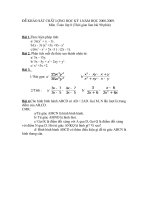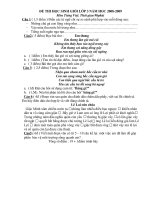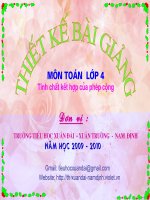Garment Defects - Textile Document
Bạn đang xem bản rút gọn của tài liệu. Xem và tải ngay bản đầy đủ của tài liệu tại đây (316.2 KB, 8 trang )
Southeast University
Southeast University
Department Of Textile Engineering
Department Of Textile Engineering
I/A 251,252 Tejgaon Dhaka Banglade
I/A 251,252 Tejgaon Dhaka Banglade
sh
sh
prepared by : Mazadul Hasan sheshir
Garment Defects
Garment Defects
Garment defects can be separated into 3 categories:
Garment defects can be separated into 3 categories:
1.
1.
Fabric defects
Fabric defects
:
:
These are defects that are found in the fabric, mostly
These are defects that are found in the fabric, mostly
these are not caused by the sewing lines. e.g. running shade,
these are not caused by the sewing lines. e.g. running shade,
selvedge to selvedge shade, holes, staining mark, missing
selvedge to selvedge shade, holes, staining mark, missing
yarn, foreign yarn, slub, hairiness etc.
yarn, foreign yarn, slub, hairiness etc.
2.
2.
Workmanship and handling defects
Workmanship and handling defects
:
:
These are defects that are directly caused by production
These are defects that are directly caused by production
section, this would include both the cutting and sewing
section, this would include both the cutting and sewing
section. Buyer’s approved samples must be referred to
section. Buyer’s approved samples must be referred to
maintain perfect workmanship.
maintain perfect workmanship.
Note
Note
: Workmanship means all the details such as
: Workmanship means all the details such as
measurement, outlook, ways of attaching trims, packing etc.
measurement, outlook, ways of attaching trims, packing etc.
Garments Defects(Contd.)
Garments Defects(Contd.)
3.
3.
Trims, accessories and embellishment defects
Trims, accessories and embellishment defects
:
:
These defects include color, size and placement of trims such
These defects include color, size and placement of trims such
as labels, sewing thread, screen print , embroidery
as labels, sewing thread, screen print , embroidery
designs, zipper, hangtag, lining , button and any kind of
designs, zipper, hangtag, lining , button and any kind of
trims.
trims.
Defects are also classified (as per extent of defect) into
Defects are also classified (as per extent of defect) into
Critical, Major and Minor defects.
Critical, Major and Minor defects.
1.Critical defects are defects that are not allowed to be
1.Critical defects are defects that are not allowed to be
shipped and are the most serious of defects (0%).
shipped and are the most serious of defects (0%).
2. Major defects are serious defects that are not allowed over
2. Major defects are serious defects that are not allowed over
a certain percentage (3%) depending on buyers
a certain percentage (3%) depending on buyers
requirements
requirements
3. Minor defects are serious defects that are not allowed over
3. Minor defects are serious defects that are not allowed over
a certain percentage (5%) depending on buyers
a certain percentage (5%) depending on buyers
requirements
requirements
Garments Defects (Contd.)
Garments Defects (Contd.)
Typical Defects:
Typical Defects:
1. Fabric defects:
1. Fabric defects:
Fabric inspection method.
Fabric inspection method.
2.Workmanship defect:
2.Workmanship defect:
a)
a)
Seam Puckering
Seam Puckering
: refers to the gathering of a seam either just after
: refers to the gathering of a seam either just after
sewing or after laundering causing an unacceptable seam
sewing or after laundering causing an unacceptable seam
appearance.
appearance.
This problem arises due to uneven stretching on to plies of fabric
This problem arises due to uneven stretching on to plies of fabric
during sewing , improper thread tension , wrong sewing thread
during sewing , improper thread tension , wrong sewing thread
selection , dimensional instability of the plies of fabric etc.
selection , dimensional instability of the plies of fabric etc.
b)
b)
Shading Variations within different parts
Shading Variations within different parts
:
:
arises due to
arises due to
improper
improper
cutting , bundling and numbering .
cutting , bundling and numbering .
Garments Defects (Contd.)
Garments Defects (Contd.)
c)
c)
Open seam or broken seam
Open seam or broken seam
: Portion of the garment that has
: Portion of the garment that has
not been covered by sewing thread.
not been covered by sewing thread.
This happens due to improper handling of the parts of garments ,
This happens due to improper handling of the parts of garments ,
improper setting and timing between needle and looper or hook
improper setting and timing between needle and looper or hook
etc.
etc.
d)
d)
Broken Stitch
Broken Stitch
: Non-continuous sewing thread.
: Non-continuous sewing thread.
It appears due to improper trimming or machine usage.
It appears due to improper trimming or machine usage.
e)
e)
Drop stitch/Skipped stitch
Drop stitch/Skipped stitch
: Irregular stitching along the seam.
: Irregular stitching along the seam.
It appears due to improper handling of cut pieces or machine
It appears due to improper handling of cut pieces or machine
usage.
usage.
Garment Defects (Contd.)
Garment Defects (Contd.)
f)
f)
Wavy/staggered stitching
Wavy/staggered stitching
:
:
Stitches are not straight. It appears due to improper
Stitches are not straight. It appears due to improper
handling of cut pieces , faulty feed mechanism , needle
handling of cut pieces , faulty feed mechanism , needle
deflection or wrong needle.
deflection or wrong needle.
g)
g)
Uncut/ loose thread
Uncut/ loose thread
:
:
Extra thread or loose thread on seam line. It appears due
Extra thread or loose thread on seam line. It appears due
to improper trimming or finishing.
to improper trimming or finishing.
h)
h)
Sizing defects
Sizing defects
(Difference in measurement of various parts
(Difference in measurement of various parts
of garments), wrong placement of pocket, buttonhole,
of garments), wrong placement of pocket, buttonhole,
embroidery and prints , measurement discrepancy- all
embroidery and prints , measurement discrepancy- all
these problems come from pattern section.
these problems come from pattern section.
Garments Defect(Contd.)
Garments Defect(Contd.)
I)
I)
Poor ironing-
Poor ironing-
if not sufficient, there might be creases and
if not sufficient, there might be creases and
crinkles on garment surface and if ironing is too heavy, there
crinkles on garment surface and if ironing is too heavy, there
might be shining mark on garment.
might be shining mark on garment.
j)
j)
misaligned buttons and holes
misaligned buttons and holes
,unfinished buttonhole, missing
,unfinished buttonhole, missing
buttons, wrong placement of labels, hang tag, wrong folding
buttons, wrong placement of labels, hang tag, wrong folding
or poor folding , improper packing into cartons – all these
or poor folding , improper packing into cartons – all these
defects come from finishing section.
defects come from finishing section.
3.
3.
Trims, accessories and embellishment defects:
Trims, accessories and embellishment defects:
Unmatched color of thread, button and zipper tape, short
Unmatched color of thread, button and zipper tape, short
zippers, faulty zippers, wrong labels, improper size of the
zippers, faulty zippers, wrong labels, improper size of the
labels, printing mistake of labels and cartons, broken poly
labels, printing mistake of labels and cartons, broken poly
bag , wrong hanger, improper embroideries and prints etc.
bag , wrong hanger, improper embroideries and prints etc.









